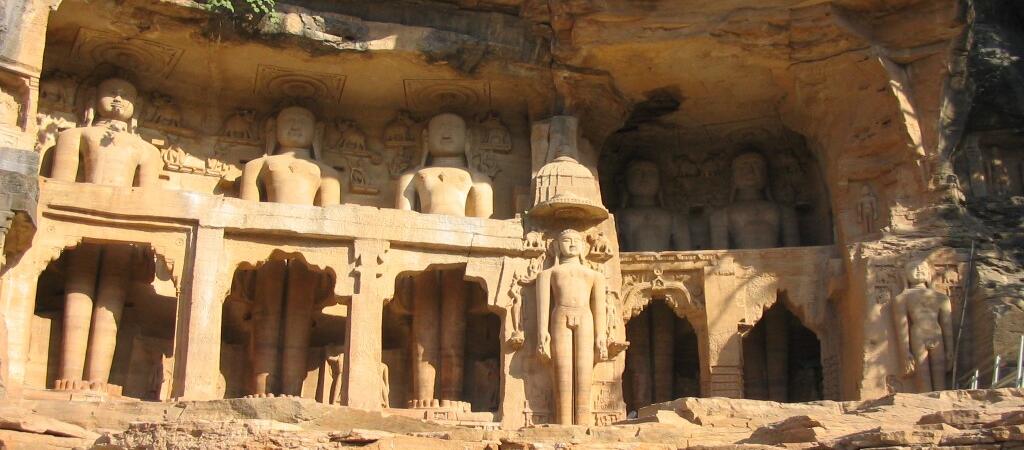The primary statement on the Jain faith and ecology is available in full-text below.
See also:
The Jain Declaration on Nature
Jain Faith Statement
By Dr. L. M. Singhvi, President of the Jain Institute, the main body bringing together the three distinct traditions of the Jains. He prepared this statement on behalf of the Institute of Jainology.
Originally published in Faith in Conservation by Martin Palmer with Victoria Finlay, published by the World Bank in 2003.
The story of Jainism
Jainism is one of the oldest living religions. The term Jain means “follower of the Jinas.” The Jinas, or spiritual victors, are human teachers who attained omniscience. They are also called Tirthankaras (ford-makers), those who help others escape the cycle of birth and death. The twenty-fourth Tirthankara, called Mahavira, was born in 599 B.C. At the age of 30, he left home on a spiritual quest. After 12 years of trials and austerities, he attained omniscience. Eleven men became his ganadharas, or chief disciples.
At 72 Mahavira died and attained nirvana, that blissful state beyond life and death. Mahavira was not the founder of a new religion. He consolidated the faith by drawing together the teachings of the previous Tirthankaras, particularly those of his immediate predecessor, Parsva, who lived about 250 years earlier at Varnasi.
Initially the followers of Jainism lived throughout the Ganges Valley in India. Around 250 B.C., most Jains migrated to the city of Mathura on the Yamuna River. Later, many traveled west to Rajasthan and Gujarat and south to Maharashtra and Karnataka, where Jainism rapidly grew in popularity. The Jain population throughout the world is less than 10 million, of which about 100,000 have settled overseas in North America, the United Kingdom, Kenya, Belgium, Singapore, Hong Kong, and Japan.
Jain practices
Jains believe that to attain the higher stages of personal development, lay people must adhere to the three jewels (ratna-traya), namely, enlightened worldview, true knowledge, and conduct based on enlightened worldview and true knowledge. They must endeavor to fulfil the anuvratas (small vows). There are five such vows:
Ahimsa (nonviolence)
This is the fundamental vow and runs through the Jain tradition like a golden thread. It involves avoidance of violence in any form through word or deed, not only to human beings but also to all nature. It means reverence for life in every form including plants and animals. Jains practice the principle of compassion for all living beings (Jiva-daya) at every step in daily life. Jains are vegetarians.
Satya (truthfulness)
“Tirthankara Mahavira” (Truth is God) said Sachham Bhagwam.
Asteya (not stealing)
This is the principle of not taking what belongs to another. It means avoidance of greed and exploitation.Brahmacharya (chastity)
This means practicing restraint and avoiding sexual promiscuity.
Aparigraha (non-materialism)
For lay Jains, this means limiting their acquisition of material goods and contributing one’s wealth and time to humanitarian charities and philanthropic causes.
Jain beliefs
Anekantavada (non-one-sidedness)
This philosophy states that no single perspective on any issue contains the whole truth. It emphasizes the concept of universal interdependence and specifically recommends that one should take into account the viewpoints of other species, other communities and nations, and other human beings.
Loka (the universe)
Space is infinite but only a finite portion is occupied by what is known as the universe. Everything within the universe, whether sentient (jiva) or insentient (ajiva), is eternal, although the forms that a thing may take are transient. Jains preach and practice the principle of the duty of every human being to promote universal well-being (sarva-mangalya).
Jiva (soul)
All living beings have an individual soul (jiva) which occupies the body, a conglomerate of atoms. At the time of death, the soul leaves the body and immediately takes birth in another. Attaining nirvana and thereby terminating this cycle of birth and death is the goal of Jain practice.
Ajiva (non-soul)
Ajiva is everything in the universe that is insentient, including matter, the media of motion and rest, time and space.
Karma
Karma is understood as a form of subtle matter that adheres to the soul as a result of its actions of body, speech, and mind. This accumulated karma is the cause of the soul’s bondage in the cycle of birth and death.
Moksha or nirvana (eternal liberation through enlightenment)
The ultimate aim of life is to emancipate the soul from the cycle of birth and death. This is done by exhausting all bound karmas and preventing further accumulation. To achieve moksha, it is necessary to have enlightened worldview, knowledge, and conduct.
Jainism as a religion of ecology
Jainism is fundamentally a religion of ecology and has turned ecology into a religion. It has enabled Jains to create an environment-friendly value system and code of conduct. Because of the insistence on rationality in the Jain tradition, Jains are always ready and willing to look positively and with enthusiasm upon environmental causes. In India and abroad, they are in the forefront of bringing greater awareness and putting into practice their cardinal principles on ecology. Their programs have been modest and mostly self-funded through volunteers.
Header photo: Gopachal Parvat Jaina monuments, Gwalior Fort, Madhya Pradesh

